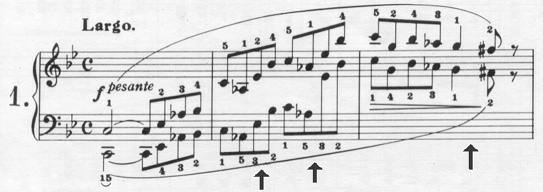* RECORDS with ERROR ; Items
4. Other composers
1) J.S.Bach ; French Suite No.5 in G major, BWV.811
- Wilhelm Backhaus(p)
- Recording ; Oct. 1956, Geneva
- Decca 433 901-2
Wilhelm Backhaus' Beethoven and Brahms are famous for the eminent masculinity, but his sincere playing is good at Bach also. This album is only one Bach recording at Decca, but this international issue by Decca has a missediting problem in Sarabande of the French Suite No.5. As the note below, Backhaus (and some other players) plays the end of the Sarabande with a variation. But about 1 second is missed!
Next score ; 37~38th bars
Playing time ; 3:49~3:54
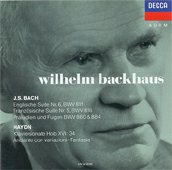 |
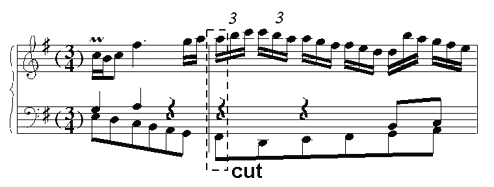 |
This error is not from original master tape but from re-editing for this international CD, because Japanese LP version(London KIJC 9011) has no erratic editing.
2) Chopin ; Préludes, op.28(+19 Nocturnes)
- Samson François(p)
- Recording ; Feb. & May 1959, Paris
- EMI CZS 5 68151 2
- Contribution ; The Classical Music, No.4(Feb. 1997)
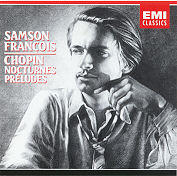 |
Samson
François' Chopin has been famous for a
long time. His individual performances have
already became the necessaries in listening
Chopin. The most frequent error in musical aspect is missediting master tape. In Prelude No.12(g sharp minor), missediting causes loss of 2 fourth rests.
I expect you to compare this to other recordings. I want to know if there is the same error in recent reissue as Toshiba HS-2088 series(TOCE-3104). |
3) Chopin ; Ballade No.1 g minor, op.23(+Préludes)
- Alfred Cortot(p)
- Recording ; 6 & 7th July 1933, Abbey Road Studio, London
- Fono Enterprise AB 78862
6 Release by Fono Enterprise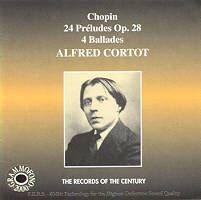 |
I doubt how the
noise
of both the releases
by Fono
Enterprise(hereafter FE) and Toshiba-EMI can be
so similar. In transferring 78s to tapes(or CD), the noise characteristics are never same in the case of the transferring by more than two companies even if they transfer the same recording. For example, Edwin Fischer's Impromptus (1938 recording) by Schubert is released by Testament, APR, and Pearl. Comparing those by APR (No.5515) and Pearl (No.9216). the latter has a pretty big surface noise in D.935-3. This phenomena result from the different surface damage of 78 sources. (If you have experience to transfer LP to tape, you will easily understand this well) Though, this FE and Toshiba-EMI's releases have same surface noises. See notes below, the first 3 bars of this ballade; I marked the noise point with dart. Please make sure by downloading mp3 files with clicking the left jacket images. The noise characteristics of the two releases is perfectly same. No hypothesis other than FE did not utilized 78s can explain it. There is no possibility that EMI gave FE the 78s used to transferring. In short, FE made this release by use of EMI's LP or CD releases.
|
6 Toshiba-EMI TOCE-7818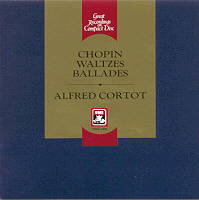 |
The
copyright of records lasts for 50 years from the
recording date(in
fact, more complicated. But in the most case of the music
of the 19th century, it is 50 years from the recording
date). In other words, anyone can transfer and
make records from the sources before 1951 - so, APR,
Pearl, Music & Arts, and Biddulph, etc. can
release the transfer records. But, they gather 78s from
the collectors and transfer to CD. This record of
Cortot's says FE does not.
This
recording is made in 1933, so the copyright of EMI
expired at 1983(FE's release is NOT ILLEGAL. I surely say this). But, anything will do
only if not illegal?
See other opinions :
>> Links ; Beethoven's complete symphonies set released by Fono Enterprise, 'Hall of Shame'
- Thomas Beecham/Berlin Philharmonic
- Recording ; November 1937, Feb. & Mar. 1938, Beethovensaal, Berlin
- EMI CHS 7 61034 2, Nimbus NI 7827/8
- Contribution ; The Classical Music, No.4(Feb. 1997) & Auditorium(Dec. 1997)
This set is issued by EMI and Nimbus, and well-known for classical recording of this work because of Hüsch's Papageno, Berger's Queen of the Night, and Beecham's baton(?). However, historical fact can be different. Adapting Korean translation of Robert Bachmann's "Karajan, Anmerkungen zu einer Karriere(Econ Verlag, Düsseldorf und Wien, 1983)"
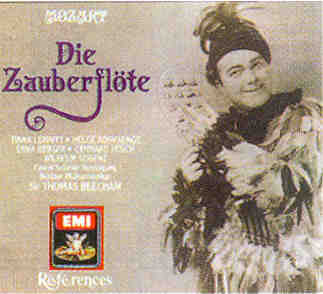 [Korean translation ; 'Musical
Emperor Karajan - the other side of the glory', translated by Kwangsik PAHN,
Published by The monthly Audio,
1990 - 186th page, note 57a]
[Korean translation ; 'Musical
Emperor Karajan - the other side of the glory', translated by Kwangsik PAHN,
Published by The monthly Audio,
1990 - 186th page, note 57a]
Walter Legge mainly produced under Electrola company(German division of HMV) at Berlin in das Dritte Reich. However, all record producing are not faithful to truth. As an example, highly evaluated "Die Zauberflöte" recording is not by Berliner Philharmoniker conducted by Beecham but by Berlin Staatsorchester Bruno Seidler. The reason is why it is totally impossible to schedule Beecham and Berlin Philharmonic when recording hall was empty. This is how to deceive record buyers, which alludes to Legge's way of thinking about the fact and credibility.
This book is very faithful to historical facts and shows writer's earnestness well, so I think he never lied groundlessly. Besides, Legge lied again - of course far from his true intention - which has me trust Bachmann. Legge released dubious air-check tape of Chopin's Concerto No.1 by Lipatti's fan1), but this was proved in 1980s as Supraphon recording of Halina Czerny-Stefanska(Polish female pianist, famous not only by her poetic playing but also by Czerny's blood in her) by an announcer of BBC(Of course Legge checked the tape with Madeleine Lipatti, Dinu's widow. But it's sure that he is not completely reliable). But Beecham's personality was as straight as he yelled audiences because of untimely applause. Could it be possible that Beecham overlooked this deception? I wish Bachmann had explained more precisely...2)
I think this recording is evaluated again if overestimated by title 'Beecham/Berlin Philharmonic". Of course, earnest reviewers said this is very good record, so it will be good one even if not conducted by Beecham. However, do record buyers have to know this and right to know it?
5) Tchaikovsky ; Symphony No.6 in b minor, op.74 "Pathétique"
- Willem Mengelberg/Royal Concertgebouw Orchestra, Amsterdam
- Recording ; 1937, Amsterdam
- Teldec 243 730-2
- Contribution ; Haruhiko KOHRI, Record Geijutsu(Record Arts; July 1993)
 Adapted from Mengelberg article in Takeshi
HASEKAWA's homepage.
Special thanks to him and his generosity. (Teldec's
international version includes only 1937 data)
Adapted from Mengelberg article in Takeshi
HASEKAWA's homepage.
Special thanks to him and his generosity. (Teldec's
international version includes only 1937 data)
* Tchaikovsky: Symphony No.6, recorded twice in 1937 and 1941
These are among Mengelberg's most popular recordings. However, Mr. Haruhiko Kohri, a Japanese historian of recorded music, set forth in an article in the record magazine, Record Geijutsu, July 1993, some startling findings. According to him, all CD transfers of the Pathetique were conflations of the two versions. The latter half of the first movement and the whole of the third movement came from the 1941 recording sessions, while the rest came from the 1937 sessions[By contrast, the early Capitol LP issued in the United States (P 8103) came entirely from the 1941 sessions, while all other LPs used the 1937 sessions]. Mr. Kohri is also a superb transfer engineer of 78s and has issued the genuine both versions through Warner Japan in 1994. They are now available in Japan and are accomplished at a quite high level. Unfortunately, however, Teldec in Germany turned down the plan to issue the series, since they prefer digital filtered sound to Mr. Kohri's natural sound. Which do you like better?
Warner Japan : WPCS-4327~30
Notes ]
1.
Reviewer Jeremy Siepmann noted the fact in the sleeve note of EMI CDH 7 63497 2 shortly. In the original sleeve note;
Owing to an administrative error with important implications for the nature of musical perception, the performance of the chopin E minor Concerto long billed as Lipatti's was shown in 1981 to be a misattribution. The real soloist on that recording turned out to have been the little-known Polish pianist Halina Czerny-Stefanska.(see DGG 18 394 LPM)
He did not mention whose mistake it is(as only administrative error). I saw the fact that it had been by Walter Legge and Mrs. Lipatti in Eumag-Donga(Korean, deceased music magazine). Siepmann mentioned Lipatti's genuine perfomance(CD source) in the note.
The genuine Lipatti version presented here derives from a private tape of the concert in question, made in 1950 by Dr. Marc Gertsch and remastered by Keith Hardwick as recently as 1981.
In short, the fake version of Lipatti's Chopin Concerto No.1 is LP without names of the conductor and orchestra. This fake is never released by CD. Fake LP is Seraphim 60007(and one of Electrola Da Capo series).
2. One of my home visitor informed me of this information(from Naxos homepage).
Reviews
This is known as the first 'complete' recording of Mozart's Die Zauberflote (even though most of the dialogue was cut). It was made in Nazi Berlin in 1937 and 1938 by subscription of the (British) Mozart Opera Society, and stands as a treasurable memento from a lost era. Sir Thomas Beecham conducts (save for the Queen's aria 'O zittre nicht' conducted excellently by Bruno Seidler-Winkler)... (See All review)
- La Scena Musicale (Philip Anson)
I have none of EMI, Nimbus, or Naxos releases - I do not have grounds of any more decision. Anyway, it is sure that all of this recording was NOT conducted by Beecham.
(c) 1997~ , Youngrok LEE ; Link free, but please get my approval before you reuse, copy, or quote this materials.
Created ; 26th Dec. 1999
Last Update ; 22nd Dec. 2001

